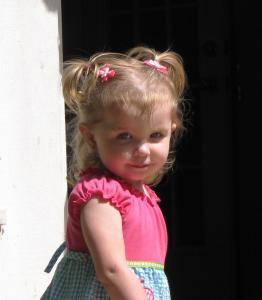Looking for design inspiration? Browse our curated collections!
December 17th, 2014 - 10:29 AM

Thereís been a photo of my granddaughter in my files for more than a year now that I thought would make a great portrait study. Savannah is three now and wasnít quite two at the time I took the photo. It was Easter and she and her sister and cousin were busy hunting for eggs that had been hidden about the yard. I was busy following them around, snapping pictures of them for posterity (and hoping to get a good shot that might turn into a nice painting). At one point I was trailing after Savannah as she walked around to the back of the house. She suddenly stood still and became quiet, seemingly in her own world. As she turned her head to look around, she saw me, her mouth curling ever so slightly into a barely perceptible smile. I snapped the picture. When I looked at it later I knew it make a nice portrait one day.
Well, that day has arrived. I want to do the portrait while Savannah is still young, before her features change too much. I have thought about doing it in color, which looks great, and which is the way I normally do portraits, but I also have a soft spot for graphite renderings. They have a simplicity about them that is very appealing. Pure tones in gray. No distracting color to get in the way. So, Iím going to do the portrait in graphite.
One of the drawbacks to graphite is the sheen nature of the medium when attempting to get darker tones. Lighter tones achieved with the harder pencils seem to turn out pretty good, but the darker B tones, when layered heavily to get really dark darks reflect light and, unless viewed from the side, become distracting Ė and annoying. Some artists avoid graphite altogether, instead choosing charcoal or carbon pencils. Using a combination of graphite and carbon pencils seems to be the best of both worlds. The harder pencils, 2H through 6H are capable of producing a wide range of soft skin tones, while the carbon pencils help achieve very dark tones such as shadows, dark hair and eyes. Highlights, especially on off white and toned paper, are produced with white charcoal and white pastel.
Iíve seen some very remarkable graphite portraits done with a combination of pencils ranging from 4H to 4B with little or no sheen produced by Darrel Tank, who has an excellent website called fivepencilmethod.com. Darrel believes that the ugly sheen attendant to very dark graphite is mostly due to mashing down the tooth on textured paper with a heavy layer of graphite so it can no longer scatter light. He feels that building up layers of graphite with a light touch will preserve the tooth, scatter light and avoid sheen.
Another fine graphite portrait artist who I admire is David Jamieson. He runs the Vitruvian Fine Art Studio (vitruvianstudio.com). David uses a range of hard pencils from 2H to 8H for fine skin tones and then 7B and 8B for darker tones such as hair and eyes and backgrounds. David avoids the graphite sheen by avoiding the darker graphite. The 7B and 8B pencils he uses are made by Staedtler and, most likely, are carbon pencils.
Choice of paper is an important consideration also. We have a few choices in texture Ė rough, cold pressed, hot pressed, smooth. And there are many good brands. The most important consideration is longevity. The paper, whatever texture, whatever brand, should be at least conservation grade, if not archival quality. But, what do these terms signify and why are they important? I never really gave it much thought, other than it is paper that will last a long time. But what does that really mean? I did a little research on the subject just to increase my knowledge and understanding. Maybe you already know all about this subject and this is old stuff for you. In that case, forgive me. But, if this is new and youíre learning something new here, we all benefit.
Art paper is made from either wood pulp or cotton pulp. Wood pulp contains lignin, an organic chemical that forms part of the cell walls of plants. When lignin decays it releases acids which can slowly destroy the paper, causing it to yellow and become brittle. Acid free, pH neutral paper can be made from wood pulp or cotton pulp. Conservation grade paper is made from wood pulp which has had the lignin removed. It is, therefore, acid free and buffered to be neutral. Archival paper (or Museum grade paper) is made from cotton pulp and contains no lignin. It, too, is acid free and pH neutral. Iím not sure that there is a big difference in longevity between Conservation grade paper and Archival paper. Anyway, a short search online didnít reveal a big difference. However, if you are really concerned about longevity, choose the archival papers made from cotton rather than the conservation papers made from lignin free wood pulp. Remember, though, that Archival paper is more expensive. If anyone can enlighten me on why archival paper would be better, please do.
My next project is a pencil drawing of my granddaughter. Iíll be doing it on Strathmore 300 Bristol Vellum. Iíll be using a combination of pencils ranging from 4H to 4B, and possibly 7B or 8B carbon. There shouldnít be too many installments to this project but itís one Iíd really like to do. Iíll post my first Update next week. Hereís the photo Iíll be doing the portrait from.
Comments
There are no comments on this blog. Click here to post the first comment.